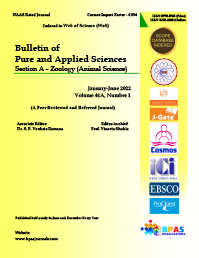Effects of Pb2+ and Cd2+ Heavy Metal Ions on the Rat Liver Mitochondrial ATP-Dependent Potassium Channel
DOI:
https://doi.org/10.48165/bpas.2023.42A.2.7Keywords:
Cd2+, Pb2, Heavy Metals, ATP-Sensitive Potassium Channel, Rat Liver Mitochondria, ATPAbstract
In the article, rat liver of Pb2+ and Cd2+ ionsthe effect on mitoKATP-channel activity in mitochondria was studied.Inhibition of mitoKATF-channel activity was observed experimentally in the presence of 200 μM concentration of ATP in the incubation medium of mitochondria isolated from rat liver.In the absence of ATP in the incubation medium, 8.0 µM concentration of Pb2+ and Cd2+ salts was noted to reduce the permeability of liver mitoKATP-channel activity in both energized and de-energized states compared to the control.
Downloads
References
Ambily Ravindran Nair, Olivier DeGheselle., Karen Smeets., Emmy Van Kerkhove and Ann Cuypers. (2013). Cadmium-Induced Pathologies: Where Is the Oxidative Balance Lost (or Not)? Int. J. Mol. Sci. 14(3), 6116-6143;
Belyaeva, E.A. Belyaeva, S.M. Korotkov, N.E. Saris. (2011). In vitro modulation of heavy metal-induced rat liver mitochondria dysfunction: a comparison of copper and mercury with cadmium. J. Trace Elem. Med. Biol., 25 (Suppl. 1); S63-S73
Cardoso A.R., Queliconi B.B., Kowaltowski A.J. (2010). Mitochondrial ion transport pathways: Role in metabolic diseases. Biochimica et BiophysicaActa. 1797, 832-838.
Cassleman, K.L.; Dorrance, K.A.; Todd, A.C. (2020). Neuropsychiatric Implications of Chronic Lead Exposure. Mil. Med. 185, e914–e918.
Charkiewicz, A.E.; Backstrand, J.R. (2020). Lead Toxicity and Pollution in Poland. Int. J. Environ. Res. Public Health. 17, 4385.
Facundo H.T., R.S. Carreira, J.G. de Paula, C.C. Santos, R. Ferranti, F.R. Laurindo, A.J. Kowaltowski, (2006). Ischemic preconditioning requires increases in reactive oxygen release independent of mitochondrial K+ channel activity. Free Radic. Biol. Med. 40, 469–479.
Fornazari M., J.G. de Paula, R.F. Castilho, A.J. Kowaltowski. (2008). Redox properties of the adenoside triphosphate-sensitive K+ channel in brain mitochondria. J. Neurosci. Res 86, 1548–1556.
Garlid K.D and Paucek P. (2003). Mitochondrial potassium transport: the K+ cycle. BiochimBiophysActa 1606, 23–41.
Gutnikova A.R., Makhmudov K.O., Saidkhanov B.A., Tojikulova O.J., Ergashev N.A., Asrarov M.I., Kosnikova I.V. (2009). About the membranotropic effect of heavy metal salts and the main ways of its correction. Toxicological Bulletin. 3, 21-27.
Jessica Briffa., Emmanuel Sinagra., Renald Blundell. (2020). Heavy metal pollution in the environment and their toxicological effects on humans. Heliyon. 6(9), e04691.
Jianbin Zhang., Peng Su., Chong Xue., Diya Wang, Fang Zhao., Xuefeng Shen and Wenjing Luo. (2022). Lead Disrupts Mitochondrial Morphology and Function through Induction of ER Stress in Model of Neurotoxicity. Int. J. Mol. Sci. 23(19).
Levin, R.; Zilli, V.C.; Rosenbaum, M.H.; Bischoff, K.; Mordarski, D.C.; Brown, M.J. (2021). The urban lead (Pb) burden in humans, animals and the natural environment. Environ. Res. 193, 110377.
Mason, L.H.; Harp, J.P.; Han, D.Y. (2014). Pb neurotoxicity: Neuropsychological effects of lead toxicity. Biomed. Res. Int. 2014, 840547.
Mironova G., Fedotcheva N., Makarov P., Pronevich L., Mironov G.P. (1981). A protein from bovine heart mitochondria that induces potassium channel conductance in lipid bilayer membranes. Biophysics. 26(3), 451-457.
**********
Nicholls D.G., S. Fergusson. (2002) Bioenergetics Academic Press. London. 3(8) 219–248.
Obeng-Gyasi, E. (2019). Sources of lead exposure in various countries. Rev. Environ. Health. 34, 25–34.
Ponomareva L.A. (2003). Environmental health is the basis of everyone’s health. Proceedings of scientific and practical research. conf. “Environmental protection and human health.”– Tashkent, 18-20.
Qiuyu Sun, Ying Li, Lijun Shi, Riaz Hussain, Khalid Mehmood, Zhaoxin Tang, Hui Zhang. (2022). Heavy metals induced mitochondrial dysfunction in animals: Molecular mechanism of toxicity. Toxicology. 469, 153136
Sarwar, N.; Malhi, S.S.; Zia, M.H.; Naeem, A.; Bibi, S.; Farid, G. (2010). Role of mineral nutrition in minimizing cadmium accumulation by plants. J. Sci. Food Agric 90, 925–937.
Satarug, S. (2012). Long-term exposure to cadmium in food and cigarette smoke, liver effects and hepatocellular carcinoma. Curr. Drug Metab.13, 257–271.
Schneider W.C., Hogeboom G.H. (1951). Cytochemikal Studies of mammalion Tissues: the Isolathion of Cell Components by Defferential Centrifugation. Cancer.res. 11, 1-22.
Skachkov M.V., Skachkova M.A., Vereshchagin N.N. (2022). Mechanisms of formation of predisposition to acute respiratory diseases in regions with high anthropogenic load. Gig. and sanitation, 5,
-42
